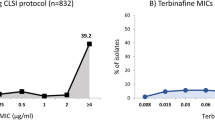Abstract
This report describes the phenotypic characteristics of a novel fungal species, isolated from a prosthetic hip infection. The patient, who had undergone multiple total hip arthroplasties due to Legg-Calvé-Perthes disease, presented with continued fever and wound dehiscence. Findings upon incision and draining were notable for necrotic tissue and a sinus tract from the fluid collection. Intraoperative cultures were positive for a sterile filamentous fungus. BLASTn results following DNA sequencing placed the isolate within the family Chaetomiaceae close to the genera Madurella, Canariomyces, Stolonocarpus, Stellatospora, Ovatospora, Carteria and Melanocarpus. Phylogenetic analysis demonstrated that the isolate was a new thielavia-like species, Pseudocanariomyces americanus. Antifungal susceptibility was performed, and low minimum inhibitory concentrations were observed with amphotericin B, itraconazole, posaconazole, and voriconazole. The patient was initially treated with voriconazole but was switched to posaconazole secondary to a photosensitivity reaction. Acceptable posaconazole trough concentrations were achieved, and the patient remained stable without pain or drainage from her surgical incision.


Similar content being viewed by others
Data Availability
DNA sequences have been deposited into GenBank; other data are available upon request to the authors.
Materials Availability
Isolates are available upon reasonable request
References
Kornerup A, Wanscher JH. Methuen handbook of colour. London: Eyre Methuen; 1978.
CLSI. Reference Method for Broth Dilution Antifungal Susceptibility Testing of Filamentous Fungi. Wayne, Pennsylvania: Clinical and Laboratory Standards Institute; 2017.
Rothacker T, Jaffey JA, Rogers ER, Fales WH, Gibas CFC, Wiederhold NP, et al. Novel Penicillium species causing disseminated disease in a Labrador Retriever dog. Med Mycol. 2020;58(8):1053–63. https://doi.org/10.1093/mmy/myaa016.
Kurtzman CP, Robnett CJ. Identification of clinically important ascomycetous yeasts based on nucleotide divergence in the 5’ end of the large-subunit (26S) ribosomal DNA gene. J Clin Microbiol. 1997;35(5):1216–23. https://doi.org/10.1128/JCM.35.5.1216-1223.1997.
Glass NL, Donaldson GC. Development of primer sets designed for use with the PCR to amplify conserved genes from filamentous ascomycetes. Appl Environ Microbiol. 1995;61(4):1323–30.
Liu YJ, Whelen S, Hall BD. Phylogenetic relationships among ascomycetes: evidence from an RNA polymerse II subunit. Mol Biol Evol. 1999;16(12):1799–808. https://doi.org/10.1093/oxfordjournals.molbev.a026092.
Minh BQ, Schmidt HA, Chernomor O, Schrempf D, Woodhams MD, von Haeseler A, et al. IQ-TREE 2: new models and efficient methods for phylogenetic inference in the genomic era. Mol Biol Evol. 2020;37(5):1530–4. https://doi.org/10.1093/molbev/msaa015.
Wang XW, Bai FY, Bensch K, Meijer M, Sun BD, Han YF, et al. Phylogenetic re-evaluation of Thielavia with the introduction of a new family Podosporaceae. Stud Mycol. 2019;93:155–252. https://doi.org/10.1016/j.simyco.2019.08.002.
Stchigel AM, Figuerra L, Cano J, Guarro J. New species of Thielavaia, with a molecular study of representative species of the genus. Mycol Res. 2002;106(8):975–83. https://doi.org/10.1017/S0953756202006299.
Noumeur SR, Teponno RB, Helaly SE, Wang X, Harzallah D, Houbraken J, et al. Diketopiperazines from Batnamyces globulariicola, gen. & sp. nov. (Chaetomiaceae), a fungus associated with roots of the medicinal plant Globularia alypum in Algeria. Mycol Res. 2020;19:589–603. https://doi.org/10.1007/s11557-020-01581-9.
Hubka V, Mencl K, Skorepova M, Lyskova P, Zalabska E. Phaeohyphomycosis and onychomycosis due to Chaetomium spp., including the first report of Chaetomium brasiliense infection. Med Mycol. 2011;49(7):724–33. https://doi.org/10.3109/13693786.2011.572299.
Badali H, Chander J, Gupta A, Rani H, Punia RS, De Hoog GS, et al. Fatal cerebral phaeohyphomycosis in an immunocompetent individual due to Thielavia subthermophila. J Clin Microbiol. 2011;49(6):2336–41. https://doi.org/10.1128/JCM.02648-10.
Barron MA, Sutton DA, Veve R, Guarro J, Rinaldi M, Thompson E, et al. Invasive mycotic infections caused by Chaetomium perlucidum, a new agent of cerebral phaeohyphomycosis. J Clin Microbiol. 2003;41(11):5302–7. https://doi.org/10.1128/jcm.41.11.5302-5307.2003.
Mhmoud NA, Santona A, Fiamma M, Siddig EE, Deligios M, Bakhiet SM, et al. Chaetomium atrobrunneum causing human eumycetoma: the first report. PLoS Negl Trop Dis. 2019;13(5):e0007276. https://doi.org/10.1371/journal.pntd.0007276.
Ahmed SA, Khan Z, Wang X, Moussa TAA, Al-Zahrani HS, Almaghrabi OA, et al. Chaetomium-like fungi causing opportunistic infections in humans: a possible role for extremotolerance. Fung Divers. 2016;76(1):11–26. https://doi.org/10.1128/JCM.30.11.3019-3023.1992.
Bourbeau P, McGough DA, Fraser H, Shah N, Rinaldi MG. Fatal disseminated infection caused by Myceliophthora thermophila, a new agent of mycosis: case history and laboratory characteristics. J Clin Microbiol. 1992;30(11):3019–23. https://doi.org/10.1128/JCM.30.11.3019-3023.1992.
Bouchara JP, Chaturvedi V. The curious case of “Case Report” of infections caused by human and animal fungal pathogens: an educational tool, an online archive, or a format in need of retooling. Mycopathologia. 2018;183(6):879–91. https://doi.org/10.1007/s11046-018-0314-1.
Funding
None.
Author information
Authors and Affiliations
Corresponding author
Ethics declarations
Conflict of interest
N.P.W. has received grant support from Astellas, bioMerieux, Cepheid, and F2G, and has served on the scientific advisory boards for Mayne Pharma. All other authors report no conflicts.
Ethical Statement
The authors confirm that the material presented in this manuscript is original and has not been published elsewhere, in whole or in part, and that all authors reviewed and approved the final version. In addition, the authors confirm completion of the checklist for submission of a case report to Mycopathologia, as published by Bouchara et al. [17].
Additional information
Publisher's Note
Springer Nature remains neutral with regard to jurisdictional claims in published maps and institutional affiliations.
Handling Editor: Ferry Hagen.
Supplementary Information
Below is the link to the electronic supplementary material.
Supplemental Figure 1.
Maximum likelihood tree based on individual phylogenies of ITS, TUB2 and RPB2 nucleotide sequences of Pseudocanariomyces americanus and related taxa in the Chaetomiaceae. Posterior probabilities (> 0.95, left) and bootstrap values (80-100%, right) are shown on the nodes. T= type strain. (TIF 406 KB)
Rights and permissions
About this article
Cite this article
Ryan, K., Cañete-Gibas, C., Sanders, C. et al. Pseudocanariomyces americanus, gen. nov., sp. nov., A New Thielavia-Like Species in the Chaetomiaceae: Identification and Management of a Prosthetic Hip Infection. Mycopathologia 186, 441–447 (2021). https://doi.org/10.1007/s11046-021-00555-z
Received:
Accepted:
Published:
Issue Date:
DOI: https://doi.org/10.1007/s11046-021-00555-z




